Page 7 of 33 pages « First < 5 6 7 8 9 > Last »
Brush pot
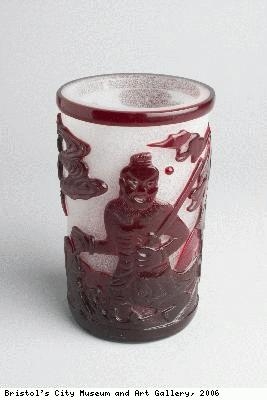
Description:
This brush-pot is packed with symbolic meanings. The bats and the warrior carrying an axe stand for happiness and bravery. The words for axe and bats (fu) both have the same sound as the Chinese character meaning happiness. The man catching a giant carp symbolises advantage, wealth and many sons, whilst the crane in the sky stands for a rise in status.
Glass, carved overlay
Height: 14.0 cm, diameter: 8.8 cm
Creator: Unknown
Date: 1800-1900, Qing dynasty
Copyright: Bristol Museums, Galleries & Archives
Object ID:N4664
Brush pot
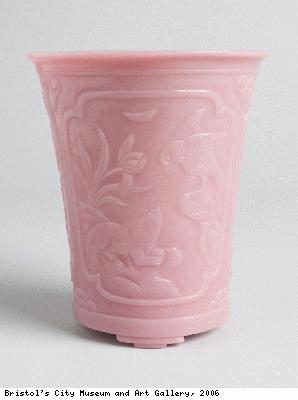
Description:
The carved symbols on each panel of this brush-pot carry different meanings through plays on words.
Bat and deer (fu lu). In Chinese these words sound the same as the words for happiness and profit from work.
Eagle and bear (yingxiong). A pun meaning heroic.
A long-tailed bird with rock (shou dai niao). A pun meaning long life.
Glass, carved in relief
Height: 9.7 cm, diameter: 8.2 cm
Creator: Unknown
Date: 1800-1900, Qing dynasty
Copyright: Bristol Museums, Galleries & Archives
Object ID:N4626
Brush pot
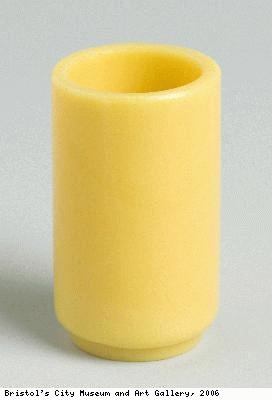
Description:
This pot would have held brushes used for calligraphy or painting.
Glass
Height: 5.5 cm, diameter: 3.3 cm
Chinese Description:
熟蛋黄玻璃笔筒 中国,清代,约1700-1900 笔洗不但可盛水,也可沾毛洗笔。 玻璃Creator: Unknown
Date: 1700-1900, Qing dynasty
Copyright: Bristol Museums, Galleries & Archives
Object ID:N4782
Planter
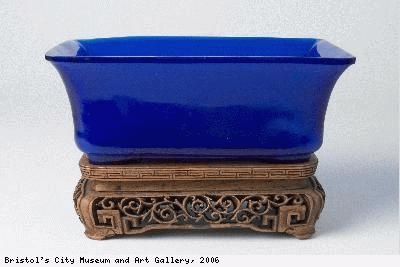
Description:
There are many references to glass pots for flowers and plants in the records of the imperial palace. For example, in 1745 the imperial glasshouse (bolichang) received an order to make 13 glass flower-pots to mark the Qianlong Emperor’s birthday.� A rectangular planter like this might be used to hold miniature plants similar to Japanese bonsai trees or daffodil and narcissus flowers, particularly at New Year.
Glass
Height: 7.7 cm, length: 19.8 cm, width: 11.9 cm
Four-character mark of Qianlong reign (1736-1795)
Chinese Description:
花盆 中国,清乾隆朝 (1736-1795) 清宫档案留下了不少资料说明这类玻璃器皿乃为插花、种植而制的。例如,1745年(乾隆10年),清廷玻璃厂制作了十三件玻璃花器用以庆贺乾隆寿辰。 刻有「乾隆年制」四字 玻璃Creator: Unknown
Date: Qianlong reign period (1736-1795)
Copyright: Bristol Museums, Galleries & Archives
Object ID:N4569
Glass Bead
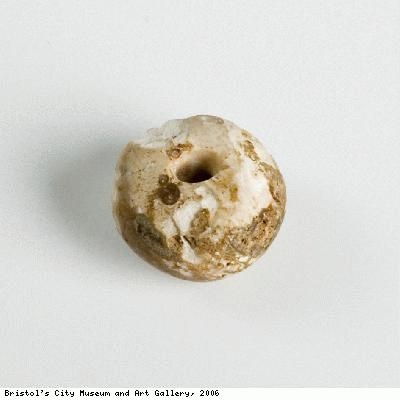
Description:
Glass beads have been found in many Han dynasty burials.
Width: 1.1 cm, length: 1.2 cm, depth: 0.8 cm
Creator: Unknown
Date: Han dynasty (206BC-220AD)
Copyright: Bristol Museums, Galleries & Archives
Object ID:N4812B
Bead
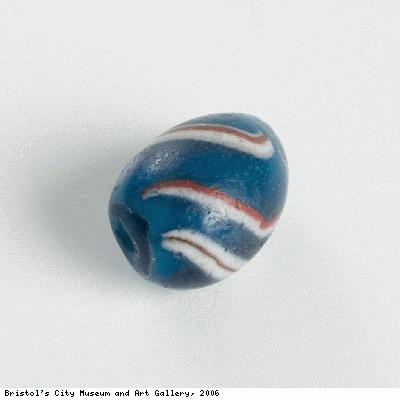
Description:
Like the amulet with the eye (00138 TEA) we are unsure of the origin of this bead. It is similar to some made in the Mediterranean area during the late Roman period (300-450 AD ) or it could date to much later. From ancient times glass beads were traded from the Middle East and Mediterranean area eastwards towards China.
Glass
Length: 1.5 cm, width: 1.1 cm
Chinese Description:
玻璃珠 地中海,约公元300-450 (﹖) 这玻璃珠与罗马帝国晚期(公元300-450)或稍晚的地中海出品甚为相像。但我们已无法查考这玻璃珠的来源。自远古以来,玻璃珠便透过商贸活动自中东及地中海等地区运至中国。 玻璃Creator: Unknown
Date: Place and date of manufacture unknown
Copyright: Bristol Museums, Galleries & Archives
Object ID:00139TEA
One of six beads
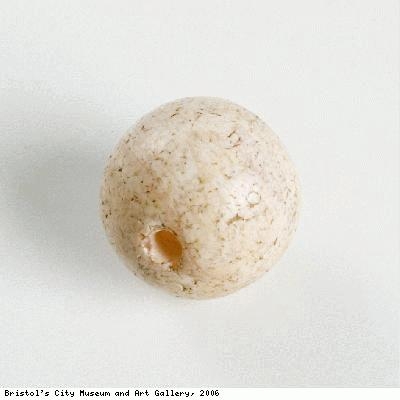
Description:
Archaeologists have found beads like this in many Chinese burial sites. These were probably made in China. Jewellery and other personal items were often placed with the bodies of the dead to accompany them in the afterlife.
Glass
Height: 1.3 cm, diameter: 1.3 cm
Chinese Description:
玻璃珠 中国,明代(1368-1644) 或清代 (1644-1911) 考古学家自中国的墓葬遗址发现不少这类玻璃珠,大抵在本土制造作随葬明器。珠宝佩饰多为入葬物品,伴随死者至阴间,玻璃珠应为廉价替代品。 玻璃Creator: Unknown
Date: Ming (1368-1644) or Qing (1644-1911)
Copyright: Bristol Museums, Galleries & Archives
Object ID:N4798-F
One of six beads
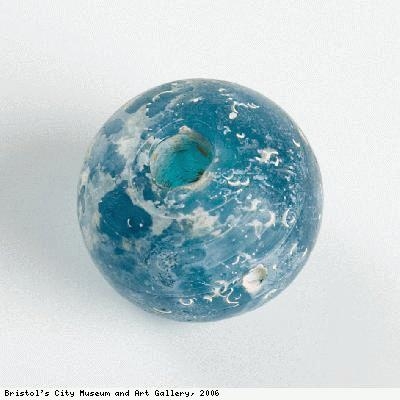
Description:
Archaeologists have found beads like this in many Chinese burial sites. These were probably made in China. Jewellery and other personal items were often placed with the bodies of the dead to accompany them in the afterlife.
Glass
Height: 1.4 cm, diameter: 1.4 cm
Chinese Description:
玻璃珠 中国,明代(1368-1644) 或清代 (1644-1911) 考古学家自中国的墓葬遗址发现不少这类玻璃珠,大抵在本土制造作随葬明器。珠宝佩饰多为入葬物品,伴随死者至阴间,玻璃珠应为廉价替代品。 玻璃Creator: Unknown
Date: Ming (1368-1644) or Qing (1644-1911)
Copyright: Bristol Museums, Galleries & Archives
Object ID:N4798-E
One of six beads
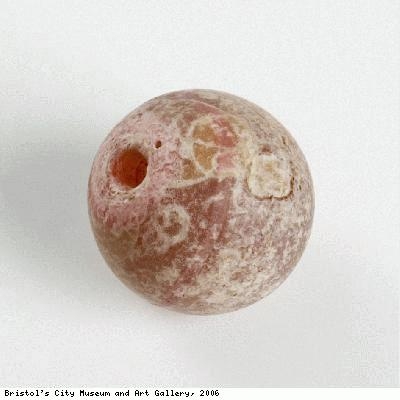
Description:
Archaeologists have found beads like this in many Chinese burial sites. These were probably made in China. Jewellery and other personal items were often placed with the bodies of the dead to accompany them in the afterlife.
Glass
Height: 1.5 cm, diameter: 1.6 cm
Chinese Description:
玻璃珠 中国,明代(1368-1644) 或清代 (1644-1911) 考古学家自中国的墓葬遗址发现不少这类玻璃珠,大抵在本土制造作随葬明器。珠宝佩饰多为入葬物品,伴随死者至阴间,玻璃珠应为廉价替代品。 玻璃Creator: Unknown
Date: Ming (1368-1644) or Qing (1644-1911)
Copyright: Bristol Museums, Galleries & Archives
Object ID:N4798-C
One of six beads
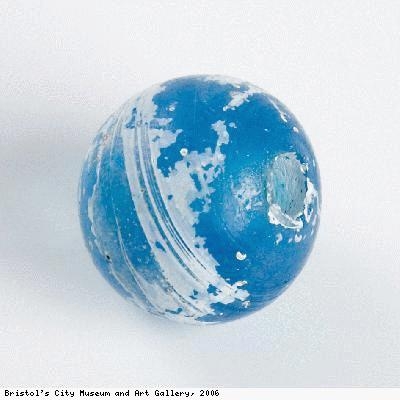
Description:
Archaeologists have found beads like this in many Chinese burial sites. These were probably made in China. Jewellery and other personal items were often placed with the bodies of the dead to accompany them in the afterlife.
Glass
Height: 1.5 cm, diameter: 1.8 cm
Chinese Description:
玻璃珠 中国,明代(1368-1644) 或清代 (1644-1911) 考古学家自中国的墓葬遗址发现不少这类玻璃珠,大抵在本土制造作随葬明器。珠宝佩饰多为入葬物品,伴随死者至阴间,玻璃珠应为廉价替代品。 玻璃Creator: Unknown
Date: Ming (1368-1644) or Qing (1644-1911)
Copyright: Bristol Museums, Galleries & Archives
Object ID:N4798-B

